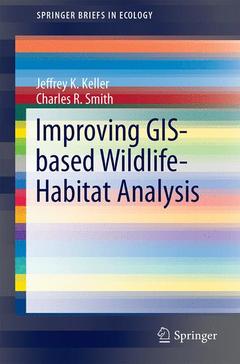Improving GIS-based Wildlife-Habitat Analysis, 2014 SpringerBriefs in Ecology Series
Langue : Anglais
Auteurs : Keller Jeffrey K., Smith Charles R.

Geographic Information Systems (GIS) provide a powerful tool for the investigation of species-habitat relationships and the development of wildlife management and conservation programs. However, the relative ease of data manipulation and analysis using GIS, associated landscape metrics packages, and sophisticated statistical tests may sometimes cause investigators to overlook important species-habitat functional relationships. Additionally, underlying assumptions of the study design or technology may have unrecognized consequences. This volume examines how initial researcher choices of image resolution, scale(s) of analysis, response and explanatory variables, and location and area of samples can influence analysis results, interpretation, predictive capability, and study-derived management prescriptions. Overall, most studies in this realm employ relatively low resolution imagery that allows neither identification nor accurate classification of habitat components. Additionally, the landscape metrics typically employed do not adequately quantify component spatial arrangement associated with species occupation. To address this latter issue, the authors introduce two novel landscape metrics that measure the functional size and location in the landscape of taxon-specific ?solid? and ?edge? habitat types. Keller and Smith conclude that investigators conducting GIS-based analyses of species-habitat relationships should more carefully 1) match the resolution of remotely sensed imagery to the scale of habitat functional relationships of the focal taxon, 2) identify attributes (explanatory variables) of habitat architecture, size, configuration, quality, and context that reflect the way the focal taxon uses the subset of the landscape it occupies, and 3) match the location and scale of habitat samples, whether GIS- or ground-based, to corresponding species? detection locations and scales of habitat use.
Chapter 1. Working Definitions.- Chapter 2. Image Resolution vs. Habitat Selection Scale in a Remote Sensing Context.- Chapter 3. Explanatory Variables.- Chapter 4. Landscape Sampling Area vs. Actual Location of Taxonomic Survey.- Chapter 5. Refining Habitat Specificity.- Chapter 6. Example Using High-resolution Imagery and Taxon-specific Variables.
Jeffrey K. Keller is a professional restoration ecologist. Charles R. Smith is a senior research associate with Cornell’s Department of Natural Resources. He also holds an adjunct associate professorship in the graduate program in biodiversity, conservation, and policy in the Department of Biological Sciences at the State University of New York at Albany.
Reviews the weaknesses of current GIS-based ecological modeling approaches and offers specific recommendations on how to improve models Introduces and demonstrates several novel covariates that significantly improve the explanatory and predictive power of species-habitat models over those currently published Offers a detailed review of the history and current state of the field Includes supplementary material: sn.pub/extras
Date de parution : 10-2014
Ouvrage de 132 p.
15.5x23.5 cm
Thèmes d’Improving GIS-based Wildlife-Habitat Analysis :
© 2024 LAVOISIER S.A.S.



